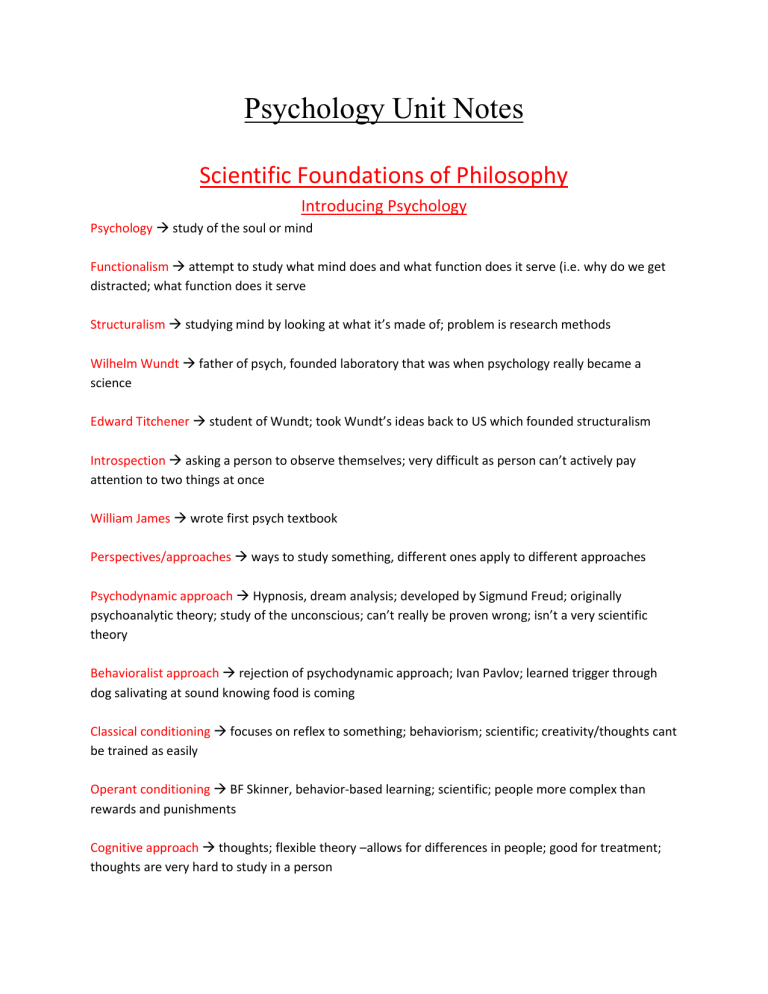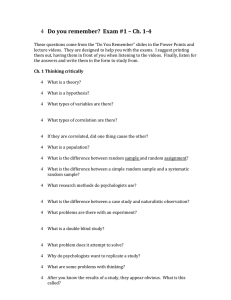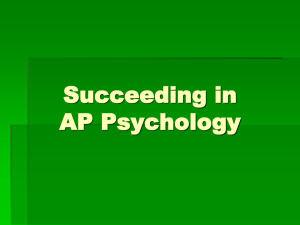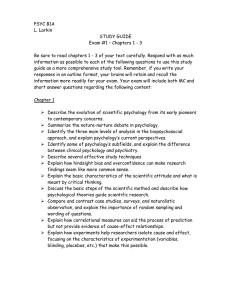
Psychology Unit Notes Scientific Foundations of Philosophy Introducing Psychology Psychology study of the soul or mind Functionalism attempt to study what mind does and what function does it serve (i.e. why do we get distracted; what function does it serve Structuralism studying mind by looking at what it’s made of; problem is research methods Wilhelm Wundt father of psych, founded laboratory that was when psychology really became a science Edward Titchener student of Wundt; took Wundt’s ideas back to US which founded structuralism Introspection asking a person to observe themselves; very difficult as person can’t actively pay attention to two things at once William James wrote first psych textbook Perspectives/approaches ways to study something, different ones apply to different approaches Psychodynamic approach Hypnosis, dream analysis; developed by Sigmund Freud; originally psychoanalytic theory; study of the unconscious; can’t really be proven wrong; isn’t a very scientific theory Behavioralist approach rejection of psychodynamic approach; Ivan Pavlov; learned trigger through dog salivating at sound knowing food is coming Classical conditioning focuses on reflex to something; behaviorism; scientific; creativity/thoughts cant be trained as easily Operant conditioning BF Skinner, behavior-based learning; scientific; people more complex than rewards and punishments Cognitive approach thoughts; flexible theory –allows for differences in people; good for treatment; thoughts are very hard to study in a person Biological approach the mind is what the brain does (what the body does); can’t have thought or emotion without brain doing something; scientific theory and can be measured (i.e. blood tests/brain scans); way too simple (i.e. brain doesn’t necessarily know what love etc. is); use medicine to treat (or surgery) Humanistic approach doesn’t focus on what’s wrong; focuses on how people are unique/special; looks for strengths of people; “bad” behavior taken into context based on person; positive, encouraging theory and promotes growth; not very scientifical; help by removing stress/barriers Sociocultural approach how people are influenced by society; difficult to apply large issues to some people Research Methods in Psychology Surveys questionaries that gather data from a person’s input; can gather large amounts of data quickly and easily, and process it easily, allows for anonymity; not always accurate with word affect, misreading questions, and dishonesty Case Studies Deep data about a specific person; provide full picture; different views of a subject; time consuming process, expensive, often occurs after event (i.e., illness), can’t assume causality, can’t be easily repeated Generalizable something applying to everyone Naturalistic Observation observing a person in “nature”, authentic data, don’t change behavior based on being studied; ethics issue with people not knowing they’re being watched, lack of control since observer doesn’t know if they’re watching (i.e., observing school on Halloween), can’t describe causality, only can deserve Longitudinal follows group and gathers data for a long time Cross Section Compare different groups, gathers data at one point in time Confounding Variables other variables that can affect a study that was intended by researcher Participants research volunteers Wording effect question written in different ways to alter participants answer Defining Psychological Science – The Experimental Method Independent variable causes change in something else Dependent variable what you get because of the experiment Hypothesis prediction, if/then statement Experimental control holding everything in the experiment constant Placebo effect think they are affected by independent variable even though it didn’t affect the participant Placebo independent variable that won’t change dependent result Random sample/selection each person in large population has equal chance of being chosen Representative sample group being studied to “look like” population Random assignment each participant has an equal chance of being put in either control or experimental group Selecting a Research Method Participant/Subject Bias consciously/unconsciously behaving in a way to ensure outcome fits expectations of experimenters (i.e., Stanford prison experiment) Single-blind procedure subjects aren’t aware if they’re in control or experimental group Experimenter/research bias since researchers want their studies to work, they want the outcome to fit their theory, so they mess up the study as they’re only looking for certain things (i.e., Stanford prison when Zimbardo wasn’t even involved in study) Double-blind procedure Researchers and experimenters don’t know if they’re in control or experimental groups Hawthorne Effect when people are observed, they tend to do the best they can at that moment Hawthorne Study 1927 in Idaho at Western Electric Company and Elton Mayo went in to study how workers could boost productivity; shorten workday and work weeks; productivity was the same in shortened days and original working schedule; flaws: no control group, sample size was only five, used different subjects chosen through study, participant, and researcher bias Statistical Analysis in Psychology Quantitative data numbers of data Qualitative Data often open-ended and descriptive Descriptive Statistics manage data into charts/data … Inferential Statistics generalize how their data applies to larger population Frequency Distribution Table how frequency each data comes up Discrete data counting by number (i.e., counting people in room) Nominal scale data without structure (i.e., tall and short) Ordinal scale count and order but not measure (i.e., strongly agree, agree etc.) Continuous data data can be measured (i.e., shoe size) Interval scale degrees of difference (i.e., people born between 1981 and 1982) Ratio scale 0 value to highest value of measure (i.e., 0 pounds to 200 pounds) Dichotomy scale two categories with organizing data Trichotomy scale three categories that organize data Central tendency mean, median, and mode Mean average of the data set Mode most common value in data set Median middle value of data set Variation range and standard deviation Range highest value minus lowest value Standard deviation average distance from the mean a point lies *don’t need to calculate on test* Normal Distribution/Bell Curve symmetrical with deviations at 68%, 95%, 99.7% Positive skew mean is pulled to higher ends of score (tail in positive area) Negative skew mean is pulled to lower ends of score (tail in negative area) Correlation coefficient how strong the relationship is between the variables (close to +1 or -1) Positive relationship positive graph with correlation Negative relationship negative graph with correlation No correlation no linear line can be drawn due to no relationship between variables Statistical significance likelihood data collection is result of experiment actually working and not left to chance P-value closest to zero, more statistical significance APA (American psychological association) formed first ethical standards to conduct research in ethical ways IR (Institutional Review Board) protect humans and animals in studies Principle A of ethics Beneficence and non-maleficence; do no harm to subjects Principle B of ethics Fidelity and responsibility; need to build positive environment for participants Principle C of ethics integrity; subjects must believe that study is trustworthy and need to know thoroughly what experiment is Principle D of ethics justice; researchers must be aware of bias so they don’t mess with study/harm experiment Principle D of ethics respect dignity and rights; subjects need to consent and agree to privacy Ethics of animals must acquire and care for animals in accordance to federal, state, and local laws Exception to principle C researchers can deceive subjects when conducting social psych studies (i.e., Milgram study) Biological Basis of Behavior Interaction of Heredity and Environment Charles Darwin ideas helped form current psych ideas (i.e., theory of evolution), we evolve certain characteristics to help us survive Cognitive neuroscience how brain is linked to mental processes (i.e., thinking/perception) Heredity nature Environment nurture Reciprocal determinism genetics are not Destiney; environment affects person, so person affects environment Epigenetics environmental pressure can change activity of genes; that change can change future generations; gene turns “on” or “off” after sustained pressure from environment; important for species Polygenic many genes; traits caused by mix of genes Diathesis disorders have genetic predisposition with environmental trigger Maturationism all children follow same pattern (i.e., rolling then crawling then walking) but doing it at different times due to environment) Plasticity brain changes in response to environment, occur quickly, helps with learning/therapy The Endocrine System Endocrine system allows for communication via blood stream, hormones talk to gland, can receive neurotransmitters too Adrenal glands on kidneys; send adrenaline into body Adrenaline trigger hypothalamus tells adrenal gland to fire Hypothalamic-pituitary-adrenal axis hypothalamus controls pituitary gland, which helps other glands, which communicates to body; top-down system Pituitary gland regulates all other glands Pineal gland produces melatonin (for sleep) Thyroid gland regulates body’s metabolism Adrenal gland produce adrenaline to help with crisis Pancreas produces insulin, help get energy from food Ovary produce estrogen and progesterone Testes produces testosterone Nervous System neurotransmitters talk to neuron, can receive hormones too Homeostasis wanting to maintain a balance Adrenaline fight or flight; short bursts Oxytocin empathy, trust, sexual activity etc. Cortisol stress hormone Testosterone sexual arousal in competition Estrogen category of hormones in reproduction; sexual desire Leptin turning of hunger Ghrelin turning on hunger Melatonin sleep process Overview of the Nervous System Central nervous system brain and spinal cord Brain weigh 3 pounds, nutrients and oxygen carried by blood vessels, protected by skull, fluid around brain protects it as shock absorber Spine transmits message from brain to body, protected by bones, thick as thumb Spinal reflex simple, automatic response to something (i.e., hammer on knee) Peripheral Nervous System parts Somatic and Autonomic Nervous System Peripheral Nervous System bundle of nerves outside of CNS, carry info to CNS and away from CNS Somatic Nervous System sensory nervous; skeletal, voluntary movement; touch, pain, temperature etc. Autonomic Nervous System involuntary and automatic activities Parasympathetic calm body down after sympathetic works Sympathetic emergency response system (not being hungry after car accident), fight or flight Neural Firing Glial cells most abundant type of cell in body Schwann cell glial cell that makes up the myelin sheath Dendrites receive chemical information Soma cell body Nucleus holds data of neuron Axon bundles of fiber carrying info away from cell body Myelin sheath helps neuron fire travel quicker Nodes of Ranvier promotes action potential Action potential “energy” when message is sent Axon terminal where dendrites are released Neurotransmitters chemicals released at end of dendrites to send signals, stored in sacs located in axon terminal Synapse space between axon terminals and other dendrite Sensory Neurons (afferent) receive information from sensory receptors and sends message to brain Motor Neurons (efferent) send information from brain to body Mirror Neurons neurons firing in response to seeing someone else do the same thing Neural transmission neurons sending messages to adjacent neurons Neurons travel 330 miles per hour, three types Resting potential more positive ions on outside of neuron than inside Permeability positive and negative ions attempt to come together to meet Action potential fires an impulse due to positive ions inside and fires through axons All or None once an electrical impulse reaches intensity level, will fire no matter what Refractory period cell can’t fire until achieve “intensity” Reuptake excess neurotransmitters left in synapse are recollected Excitatory neurotransmitters stimulate firing of message Inhibitory neurotransmitters slow or stop messages from sensing Acetylcholine enables muscle action, learning, and memory, lead to Alzheimer Dopamine movement, learning, attention, and emotion (schizophrenia with too much), can lead to Parkinson’s (undersupply) Serotonin hunger, mood arousal, and sleep; undersupply = depression Endorphins pain control, pleasure during great bodily stress Epinephrine energy, form memory Norepinephrine alertness, blood pressure, heart rate, release glucose for fight or flight response Glutamate excitatory involved in memory; oversupply = migraines/seizures GABA major inhibitor that stops you; undersupply = seizures, tremors, insomnia Influence of Drugs on Neural Firing Agonist drug that affects neuron by doing what a neurotransmitter would do Antagonist drug that blocks what a neurotransmitter would do Reuptake neurotransmitters travel back into neurotransmitters Reuptake inhibitor stop reuptake process from happening, more neurotransmitter stays in synapse and is then released Opiates mimic endorphins (pain killers), euphoria; highly addictive Dopamine Agonists (L-Dopa) mimic for dopamine; helps for people with Parkinson’s to stop tremors Botulinum Toxin (Botox) blocks acetylcholine (released by muscle contraction), muscles don’t contract Alcohol antagonist for glutamate (excitatory neurotransmitter); acts as depressant for nervous system SSRI’s selective serotonin reuptake inhibitors; helps with anxiety and depression The Brain 3 Major Brain Regions Hindbrain, Midbrain, Forebrain Hindbrain most primitive part of brain; base of brain; basic survival Midbrain more sophisticated; located in the middle of the brain Hindbrain structures Pons, medulla oblongata, cerebellum, reticular formation Medulla oblongata very base of brain; autonomic functions happen here (i.e. respiration, blood pressure) Pons autonomic functions (i.e., sleep cycles, communicate between cerebellum and forebrain, bladder control) Cerebellum back and base of brain; “little brain”; balance; posture; coordination; memories needed for easy actions (i.e., getting water) Reticular Formation attention, arousal, consciousness Limbic System emotional brain; work together to process emotions Thalamus routes incoming sensory system to higher parts of brain to interpret signals Hypothalamus/pituitary gland maintain homeostasis (i.e., temperature and hunger), works with hypothalamus; controls other glands in body, i.e., fight or flight, social bonding, reward pathway Amygdala emotional reactions (i.e., fear or aggression) Hippocampus memory formation, learning, emotional regulation Cerebral cortex/Fore brain divided into two hemispheres and four lobes Four lobes of brain frontal, parietal, temporal, occipital Frontal lobes motor control, judgment, planning, thinking Broca’s area speech, which words should be used, produce speech Motor cortex each side controls opposite muscles on the side of body Parietal lobe sensory Somatosensory cortex responsible for senses on skin Association areas all lobes connect to form memories and process thoughts Occipital primary visual cortex, process what you see Temporal auditory cortex and association areas Wernicke’s area allows for auditory comprehension Tools for Examining Brain Structure and Function Henry Moliason (HM) consistent seizures; surgeon removed part of brain; couldn’t form new memories but did have memories prior to surgery; Wilder Penfield and Brenda Milner studied him at MIT; determined function of hippocampus was for forming and storing long term memories TAN (Louis Victor Leborgne) suffered stroke; few months later could only say tan; right side of body became prepared; damage to left hemisphere; Paul Broca studied brain Broca’s aphasia inability to produce speech; often from stroke Phineas Gage pole through head; prefrontal cortex (planning, judgement, emotional regulation); became more aggressive, couldn’t plan/judge Solution for epilepsy split brain procedure Split brain right visual field left visual cortex; say what they saw Split brain left visual field can’t see anything; could draw image with left hand Left Hemisphere language, logic Right Hemisphere spatial, facial, recognition EEG electroencephalogram; electrodes placed on head; detect electrical activity of neurons; brain waves determine where brain is active; used for stages of sleep PET Positron Emission Tomography; injected with trace amount of radioactive glucose (energizes neurons); scanner picks up on activity of brain; enable us to map activity MRI Magnetic Resonance Imaging; place in MRI machine; low level magnetic field; pulse distorts magnetic field and atoms in body; produce image slices of brain; very detailed fMRI functional Magnetic Resonance Imaging similar to MRI; measures oxygen and blood flow (similar to glucose in PET scan) The Adaptable Brain Psychoactive drug chemical substance; used to purposefully alter one’s perception, mood, consciousness; often addicting Four psychoactive drug categories depressants, opioids, stimulants, and hallucinogens Depressants reduce neural activities; slow body functions; relief is symptom (i.e., alcohol, sleeping pills); opioids technically a type; impairs brain judgement Opioids depressant effect; pain relief (offer like endorphin); examples are morphine, heroin etc. Stimulants drugs that excite neural activity; speed up body functions; caffeine, nicotine, cocaine are examples Hallucinogens psychedelics; evoke hallucinations; examples are LSD and Marijuana Hallucination sensation in absence of sensory input Mesmer put people in tranced state; made people feel better but only because patients thought it was helping, not because of science Hypnosis calm trance like state with heightened focus; can’t make you act against will; not reliable to find deeply bound memories dissociation split consciousness; don’t know self tolerance more you use substance, less you feel effect Sleep and Dreaming Sleep cycle NREM 1, NREM 2, NREM 3, REM Sleep stages different psychological/physical changes; every 90-120 minutes NREM 1 (Non-Rapid eye movement) very light sleep; nap stage; alpha waves, which are calm but active NREM 2 transitional stage, theta waves (deeper into sleep/harder to wake up) NREM 3 everything very slowed, very hard to wake up, delta wave, emit growth hormone, muscles building, shorter throughout night; sleep walking; essential for body REM external muscles become paralyzed; beta waves emitted (which is when you're alert too); longer through night; dream stage; memories synthesis; essential for mind Night terror sleep panic attack Nightmare occur in REM Restoration theory bodies wear out through day, so sleep to restore; help brain make networks Adaptive Theory sleep protects us; product of what out brain does; brain primed to slow down energy during day and increase during night; safer from predators in day than night/dark Cognitive and Information Processing Theories helps restore/build memories; consolidation occurs during REM; people deprived of REM sleep struggle cognitively Sigmond Freud theory on dreams wrote “The Interpretation of Dreams”; dreams are road to unconscious; manifest and latent content; not very scientific Manifest content what you remember Latent content symbolic underlying of dreams Activation Synthesis Model REM helps preserve and develop neural connections; REM triggers neural activity and cortex as memories are synthesized Insomnia inability to fall asleep, stay asleep, or both; most common sleep disorder; adults need 7-9 hours of sleep; teens need 8-10 hours of sleep Causes of Insomnia Stress; irregular sleep schedule; pain/illness; diet/medications Treatment of Insomnia stress management; medications/melatonin; treatment of pain/illness; changing habits Sleep Apnea lack of breathing during sleep; breathing stops repeatedly; can’t go to NREM 3 or REM Three types of Apnea obstructive, central, complex Obstructive Apnea obstructive in throat Central Apnea brain stops breathing Complex Apnea both central and obstructive apnea Treatment for Apnea CPAP; hooked to machine with proper oxygen airflow Narcolepsy sleep attacks throughout day; drowsiness; straight into REM Cataplexy muscle paralysis Treatment of Narcolepsy medication Birbiglia jumped through window while sleeping because dreamed missel flying at him and he had to escape Aserinsky 8-year-old who had electrodes on head by father; discovered REM Awake hormone cortisol, hypocretin Oneirology study of dreams Sensation and Perception Principles and Sensation Gestalt psychology origin of cognitive psychology; Wertheimer, Köhler, Koffka, Perls; the whole is greater than the sum of its parts Oliver Sacks brilliant professor, but can’t recognize faces Prosopagnosia can’t recognize faces Sensation bottom up; receive information Perception top down; interpret information Absolute threshold of sensation minimum stimulation needed to sense 50% of the time Signal detection theory predict how or when people detect certain stimuli Difference threshold how to tell the difference between sensations Weber’s law perceive differences on logarithmic scales Greater amplitude brighter color Rods detect for peripheral vision/gray scale Cones detect bright color/in well-lit conditions Trichromatic theory three cones see red green and blue and mix together to see color Opponent-process theory cells inhibit each other Feature detectors respond to specific shapes/movements/etc. Homunculus what we sense (proportionally; mostly hands and mouth) Short waves high frequency and pitch Amplitude (sound) loudness, in decibels Directional stereophonic hearing 3D hearing Cochlea make auditory movement translated into brain to determine what sound is Umami meat taste Sensory interaction one sense influences the other Synesthesia one sense takes over other senses Chemical senses airborne molecules to sense 4 parts of touch pressure, warmth, cold, pain Kinesthesis body sensing own body/movement Vestibular sense position and balance (vestibular sacs of fluid in ear) Perceptual set psychological set determining how you see your environment (impacted by emotion, culture, …) Figure ground perception how we simplify what were looking at (i.e. face and vase) Proximity organize groups (i.e., people) Depth perception ability to see 3D even though it hits you in 2D Binocular cues require both eyes to see Retinal disparity closer object, greater difference between two images (binocular cues) Monocular cues for far distances; only need one eye; (needed for relative size/height, linear perspective, texture gradient, interposition) Relative size/height things are behind, not on top Linear perspective parallel lines appear to meet as they move into distance Texture gradient farther away objects become less detailed Interposition when something blocks vision, know its closer Motion perception speed of moving object (i.e. shrinking objects leaving) Constancy continue to recognize object even though different shapes/colors/etc. Dual processing simultaneously processing on conscious and unconscious Selective attention focus on what matters at the time Selective inattention don’t pay attention to things (even obvious) Inattentional blindness can’t see obvious things when paying attention to something else Change blindness can’t see change in environment (i.e. don’t know someone has changed shirts Learning Cognitive Psychology Developmental Psychology Motivation, Emotion, and Personality Consciousness awareness of ourselves/environment Clinical Psychology Social Psychology



